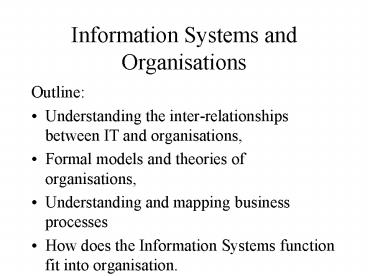Information Systems and Organisations - PowerPoint PPT Presentation
1 / 28
Title:
Information Systems and Organisations
Description:
Information Systems and Organisations Outline: Understanding the inter-relationships between IT and organisations, Formal models and theories of organisations, – PowerPoint PPT presentation
Number of Views:342
Avg rating:3.0/5.0
Title: Information Systems and Organisations
1
Information Systems and Organisations
- Outline
- Understanding the inter-relationships between IT
and organisations, - Formal models and theories of organisations,
- Understanding and mapping business processes
- How does the Information Systems function fit
into organisation.
2
ORGANIZATIONS INFORMATION TECHNOLOGY
MEDIATING FACTORS Environment
Culture Structure
Standard Procedures Politics
Management Decisions
Chance
3
ORGANIZATION
- FORMAL DEFINITION
- - stable, formal structure
- takes resources/inputs from environment
capital, labour, materials, knowledge(?) etc - processes them
- to produce outputs
4
STRUCTURAL CHARACTERISTICS OF ALL ORGANIZATIONS
- Clear division of labor
- Hierarchy
- Explicit rules procedures standard operating
procedures (sop) - Objective/impartial judgments
- Technical qualifications
- Strive for maximum organizational efficiency
5
BEHAVIORAL VIEW OF ORGANIZATIONS
- STRUCTURE Hierarchy Division of
labor Rules, Procedures - PROCESS Rights/Obligations
Privileges/Responsibilities Values Norms
People
6
TYPES OF ORGANIZATIONS
- ENTREPRENEURIAL Startup business
- MACHINE BUREAUCRACY Mid-sized manufacturing firm
- DIVISIONALIZED BUREAUCRACY Very Large,
multi-business/multi-divisional corporations - PROFESSIONAL BUREAUCRACY Law firms, hospitals
- ADHOCRACY Consulting firm
7
ORGANIZATION ITS ENVIRONMENT
8
BROADER VIEW OF ORGANIZATIONS
- COMMON FEATURES
- FORMAL STRUCTURE
- STANDARD OPERATING PROCEDURES
- POLITICS
- CULTURE
3.11
9
SALIENT FEATURES OF ORGANIZATIONS
- UNIQUE FEATURES
- ORGANIZATIONAL TYPE
- ENVIRONMENTS, GOALS, POWER
- CONSTITUENCIES, FUNCTION
- LEADERSHIP, TASKS
- TECHNOLOGY
- LEVELS
10
Business Process The unique breakdown and
sequence of activities that an organisation
specifies for the completion of a task.
Typically we refer to tasks that cut across
multiple functions or departments. Eg. Order
fulfillment, new product introduction
11
(No Transcript)
12
WORK GROUPS, PROBLEMS, SYSTEM SUPPORT
- HIERARCHICAL Frequent meetings, workers
dispersed - VIDEO CONFERENCING, E-MAIL
- INTERDEPARTMENTAL COMMITTEES Need occasional
direct communication - ELECTRONIC MESSAGING
13
WORK GROUPS, PROBLEMS, SYSTEM SUPPORT
- PROJECT TEAMS Day-to-day interactions, meeting
schedules - SCHEDULING/COMMUNICATION/ SUPPORT SOFTWARE,
INTRANET - COMMITTEES High peak load, intermittent
communication - ELECTRONIC BULLETIN BOARDS, VIDEO/COMPUTER
CONFERENCING, E-MAIL
14
WORK GROUPS, PROBLEMS, SYSTEM SUPPORT
- TASK FORCES Rapid communication,
internal/external data - GRAPHICS DISPLAY, INFORMATION/ DOCUMENTATION
INTERCHANGE - PEER GROUPS Intense personal communication
- TELEPHONE, E-MAIL
15
PROBLEMS OF ALL WORK GROUPS
- Making arrangements
- Attending meetings
- Long agenda
- Cost of meetings
- Between-meeting activities
16
DEVELOPMENT OF INFORMATION ARCHITECTURE
- 1950s ELECTRONIC ACCOUNTING MACHINES
- 1960s DATA PROCESSING DEPARTMENTS
- 1970s INFORMATION SYSTEMS
- 1980s INFORMATION SYSTEMS SERVICES
- 1990s ENTERPRISE-WIDE INFORMATION UTILITY
17
INFORMATION SYSTEMS DEPARTMENT
- PROGRAMMERS Write software
- SYSTEMS ANALYSTS Translate business problems
into solutions - Data Administrators in charge of managing the
information resources of the org. - IS MANAGERS Department leaders
- Chief Information Officer (CIO)
- END USERS Department reps for whom applications
are developed
18
PERSPECTIVES ON ORGANIZATIONS AND THE ROLE OF IT
- MICROECONOMIC MODEL/THEORY OF THE FIRM The
outputs of the firm as a function of key factors
of production such as capital C, labor L, and
knowledge K. Investments in IT can lead to
increase in K and reduction overall L.
19
PERSPECTIVES ON ORGANIZATIONS AND THE ROLE OF IT
- AGENCY/TRANSACTION COST THEORY Firm is nexus of
contracts among agents who make decisions. The
firms attempts to minimise transaction costs in
contracting. IS/IT shrink number of agents
reduce transaction costs. - BEHAVIORAL THEORIES Concepts from Psychology,
Political Science Organizations Information
Technology mutually influence each other.
Implementation strategies, resistance..
20
PERSPECTIVES ON ORGANIZATIONS AND THE ROLE OF IT
- DECISION CONTROL THEORY Decisions are made
under conditions of risk uncertainty
centralization hierarchy can reduce uncertainty
in certain circumstances. - SOCIOLOGICAL THEORY Bureaucracy, SOPs help
stabilize organizations, but slow ability to
change
21
PERSPECTIVES ON ORGANIZATIONS AND THE ROLE OF IT
- POSTINDUSTRIAL THEORY Flatter organizations
dominated by knowledge workers decentralized
decision making - CULTURAL THEORY Information technology must fit
organizations culture to be accepted
22
PERSPECTIVES ON ORGANIZATIONS AND THE ROLE OF IT
- POLITICAL THEORY Info systems are outcome of
political competition among coalitions and groups
for power and resources.
23
IMPLEMENTING CHANGE
24
HOW INTERNET AND THE WORLD WIDE WEB AFFECT
ORGANIZATIONS
- More info, anywhere, anytime/potential
information overload - More scope, depth, range of knowledge
- Lowers cost, potential to raise quality of info
distribution
25
Types of Decisions
- Well-Structured decisions
- Semi-structured decisions
- Unstructured or ill-structured decisions
- They lie along a continuum.
26
INFO SYSTEMS, LEVELS, DECISIONS
27
STAGES OF DECISION MAKING
- INTELLIGENCE Collect information identify
problem - DESIGN Conceive alternatives select criteria
- CHOICE Use criteria to evaluate alternatives
select - IMPLEMENTATION Put decision into effect
allocate resources control
SOURCE Simon, The New Science of Management
Decision (1960)
28
MODELS OF DECISION MAKING
- RATIONAL MODEL Assumes comprehensive rationality
- comprehensive search for alternatives, their
systematic evaluation against objectives,
choosing the alternative that maximises value. - Satisficing Models Based on the concept of
bounded rationality - people do not have the
cognitive capacity to be comprehensively
rational hence they satisfice. - Political Model































